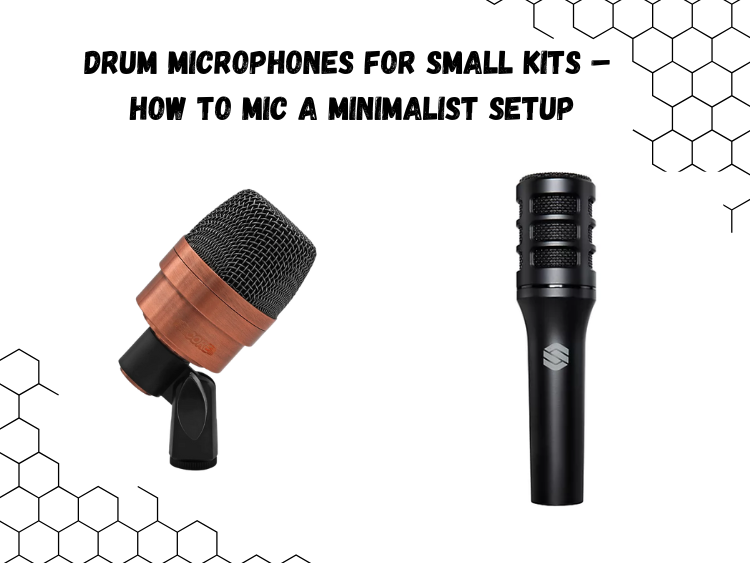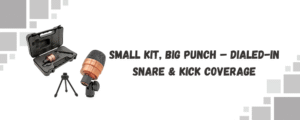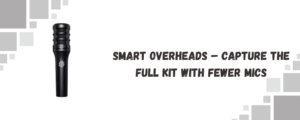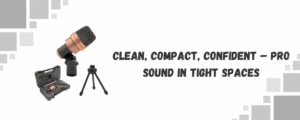You don’t need a monster kit to make a big impact. In fact, more and more drummers are scaling down—tight setups, tight sound, tighter focus. But even when you’re playing a three- or four-piece kit, your sound still matters. And the truth is, miking a small drum kit isn’t about using fewer mics—it’s about using the right ones in the right places.
This guide is for drummers who’ve stripped things down to the essentials. Whether you’re recording in a compact home studio or gigging with a portable setup, here’s how to get pro-level sound out of a minimalist kit.
Why Less Can Actually Sound Like More
A smaller kit has fewer components competing for space. That gives your microphones more room to breathe—and more opportunity to focus in. With the right mics and placement, you can capture the full dynamics of your playing without crowding the sound.
You’ve got a kick, snare, maybe a rack tom and a floor tom. Cymbals? A ride and a crash if you’re lucky. That’s it. So every mic has to work overtime. The good news? If you know where to point them, two to four mics is all you really need.
Start With the Snare – Always
If your snare doesn’t cut through, nothing else matters. It’s the heartbeat of your kit, and it deserves a proper mic. A dynamic cardioid mic works best here—something that can handle high SPLs, reject bleed from nearby cymbals, and still give you the crack and body you want.
The 5 Core Tom Snare Mic nails that balance. It’s tight, directional, and tough. Even if you’re playing in a tight corner of a bar, this mic keeps the snare front and center, where it belongs.
Mic it slightly off-center from the head, angled downward to capture both snap and depth. Don’t aim straight at the shell—you’ll get too much ring. A 45-degree angle, a couple inches above the rim, does the trick.
Kick Drum – No Mud, No Boom, Just Punch
A lot of minimalist drummers use compact bass drums—18″ or even smaller. That doesn’t mean you need to sacrifice low-end. But it does mean your mic choice matters more.
If you’re working in tight spaces, a dedicated kick mic can be overkill. A dynamic instrument mic with a decent low-end response can still get you there. Tuck it just inside the port hole (if your reso head has one), or place it a few inches off the head if you’re working with a closed front.
You want definition over rumble. That attack when the beater hits the head—that’s your golden frequency. A smaller mic with a tailored cardioid pattern keeps the focus tight and rejects room noise.
Overheads – The Secret Sauce of Small Kits
If you’re only using one overhead, make it count. Condenser mics are your best friend here—especially ones that can grab the full kit from a single point. You want crisp cymbals, a little snare snap, and maybe even some tom resonance in the mix.
Go slightly above the drummer’s head, angled toward the snare. Centered overheads often give you a more balanced image, especially when you’re not miking every individual drum. If you’ve got two condensers, use a spaced pair or XY pattern—just make sure you’re phase-aware.
For small kits, your overheads are your tom mics. If you’re using a compact tom/snare mic for a single tom, that’s a bonus—but don’t rely on it for the full picture. Your overheads will capture the natural decay and air your kit needs.
Recording vs. Live – Adjust Accordingly
In a recording setup, you have time to play with mic positions. You can tweak angles, adjust distances, and add treatment to control the room. But on stage, speed and simplicity matter.
For live shows with a small kit, a 3-mic setup usually works best: kick, snare, and one overhead. It’s fast, it’s clean, and it minimizes feedback issues. Just make sure your overhead isn’t pointed directly at the stage monitors.
Some drummers even go two-mic—kick and overhead. It’s not ideal for every genre, but for jazz, indie, or acoustic sets, it can absolutely work.
And if you’re playing a stripped-down set in a tight venue, a solid compact mic like the Shure PGA56 can work wonders—stays out of the way, locks in tight on snares or toms, and keeps your setup light.
Tips for Tight Spaces
- Clip-on mics save space and reduce clutter. Fewer stands = more room to play.
- Foam isolation under kick drum mics can help reduce stage rumble.
- Use EQ cuts instead of boosts—especially with small kits. Let the natural sound breathe.
- Get your phase right. With only a few mics, phase problems show up fast. Always check for cancellation, especially between overheads and snare/kick.
Final Thoughts
Mic’ing a small drum kit is all about intention. You’re not just throwing mics around—you’re making strategic choices to get the most out of every hit. With a good snare mic, a focused kick setup, and one or two overheads, you’re already 90% there.
And the gear doesn’t have to be flashy. It just has to work. Tools like the 5 Core tom/snare dynamic mic are built exactly for this kind of setup—compact, punchy, and made to handle the pressure without losing clarity.
Because in the end, small kits still deserve big sound.




